Challenges for Simulating Growth and Phenology of Silage Maize in a Nordic Climate with APSIM
Abstract
1. Introduction
2. Materials and Methods
2.1. Field Data
2.2. Description of APSIM-Maize
2.3. APSIM-Maize Parameterisation
2.4. Calibration Protocol
3. Results
3.1. Weather Data
3.2. Calibration of the Phenological Parameters
3.3. Simulation of Above-Ground Dry Matter Yield
4. Discussion
4.1. Calibration of the Phenological Parameters
4.2. Simulation of Above-Ground Dry Matter Yield
4.2.1. The Radiation use Efficiency
4.2.2. Light Interception Efficiency
4.2.3. The Light Interception Efficiency
5. Conclusions
Author Contributions
Funding
Acknowledgments
Conflicts of Interest
References
- FAO; FAOSTAT. CROPS (Dataset). (Latest Update: 28/05/2018). Available online: http://www.fao.org/faostat/en/#data/QC (accessed on 6 July 2018).
- Filya, I. Nutritive value and aerobic stability of whole crop maize silage harvested at four stages of maturity. Anim. Feed Sci. Technol. 2004, 116, 141–150. [Google Scholar] [CrossRef]
- Fogelfors, H.; Wivstad, M.; Eckersten, H.; Holstein, F.; Johansson, S.; Verwijst, T. Strategic Analysis of Swedish Agriculture; Institutionen för växtproduktionsekologi, Sveriges lantbruksuniversitet: Uppsala, Sweden, 2009; ISBN 91-86197-55-X. [Google Scholar]
- Givens, D.I.; Deaville, E.R. Comparison of major carbohydrate fractions and cell wall digestibility in silages made from older and newer maize genotypes grown in the UK. Anim. Feed Sci. Technol. 2001, 89, 69–82. [Google Scholar] [CrossRef]
- Jordbruksverket. Swedish Board of Agriculture. (In Swedish). 2018. Available online: http://www.jordbruksverket.se/amnesomraden/odling/jordbruksgrodor/majs/skordestatistik.html (accessed on 6 July 2018).
- Pachauri, R.K.; Allen, M.R.; Barros, V.R.; Broome, J.; Cramer, W.; Christ, R.; Church, J.A.; Clarke, L.; Dahe, Q.; Dasgupta, P. Climate Change 2014: Synthesis Report. Contribution of Working Groups I, II and III to the Fifth Assessment Report of the Intergovernmental Panel on Climate Change; IPCC: Geneva, Switzerland, 2014; ISBN 92-9169-143-7. [Google Scholar]
- Eckersten, H.; Herrmann, A.; Kornher, A.; Halling, M.; Sindhøj, E.; Lewan, E. Predicting silage maize yield and quality in Sweden as influenced by climate change and variability. Acta Agric. Scand. Sect. B—Soil Plant Sci. 2012, 62, 151–165. [Google Scholar] [CrossRef]
- Atlin, G.N.; Cairns, J.E.; Das, B. Rapid breeding and varietal replacement are critical to adaptation of cropping systems in the developing world to climate change. Glob. Food Secur. 2017, 12, 31–37. [Google Scholar] [CrossRef]
- Bouman, B.A.M.; Van Keulen, H.; Van Laar, H.H.; Rabbinge, R. The ‘School of de Wit’crop growth simulation models: A pedigree and historical overview. Agric. Syst. 1996, 52, 171–198. [Google Scholar] [CrossRef]
- Di Paola, A.; Valentini, R.; Santini, M. An overview of available crop growth and yield models for studies and assessments in agriculture: Overview of crop models for agriculture. J. Sci. Food Agric. 2016, 96, 709–714. [Google Scholar] [CrossRef]
- Bassu, S.; Brisson, N.; Durand, J.-L.; Boote, K.; Lizaso, J.; Jones, J.W.; Rosenzweig, C.; Ruane, A.C.; Adam, M.; Baron, C.; et al. How do various maize crop models vary in their responses to climate change factors? Glob. Chang. Biol. 2014, 20, 2301–2320. [Google Scholar] [CrossRef]
- Phelan, D.C.; Harrison, M.T.; Kemmerer, E.P.; Parsons, D. Management opportunities for boosting productivity of cool-temperate dairy farms under climate change. Agric. Syst. 2015, 138, 46–54. [Google Scholar] [CrossRef]
- Phelan, D.C.; Parsons, D.; Lisson, S.N.; Holz, G.K.; MacLeod, N.D. Beneficial impacts of climate change on pastoral and broadacre agriculture in cool-temperate Tasmania. Crop Pasture Sci. 2014, 65, 194. [Google Scholar] [CrossRef][Green Version]
- Mesbah, M.; Pattey, E.; Jégo, G. A model-based methodology to derive optimum nitrogen rates for rainfed crops—A case study for corn using STICS in Canada. Comput. Electron. Agric. 2017, 142, 572–584. [Google Scholar] [CrossRef]
- Phelan, D.C.; Harrison, M.T.; McLean, G.; Cox, H.; Pembleton, K.G.; Dean, G.J.; Parsons, D.; do Amaral Richter, M.E.; Pengilley, G.; Hinton, S.J.; et al. Advancing a farmer decision support tool for agronomic decisions on rainfed and irrigated wheat cropping in Tasmania. Agric. Syst. 2018, 167, 113–124. [Google Scholar] [CrossRef]
- Peake, A.S.; Das, B.T.; Bell, K.L.; Gardner, M.; Poole, N. Effect of variable crop duration on grain yield of irrigated spring-wheat when flowering is synchronised. Field Crops Res. 2018, 228, 183–194. [Google Scholar] [CrossRef]
- Peake, A.S.; Gilmour, A.; Cooper, M. The 1BL/1RS translocation decreases grain yield of spring wheat germplasm in low yield environments of north-eastern Australia. Crop Pasture Sci. 2011, 62, 276. [Google Scholar] [CrossRef]
- Setiyono, T.D.; Weiss, A.; Specht, J.; Bastidas, A.M.; Cassman, K.G.; Dobermann, A. Understanding and modeling the effect of temperature and daylength on soybean phenology under high-yield conditions. Field Crops Res. 2007, 100, 257–271. [Google Scholar] [CrossRef]
- Gaiser, T.; de Barros, I.; Sereke, F.; Lange, F.-M. Validation and reliability of the EPIC model to simulate maize production in small-holder farming systems in tropical sub-humid West Africa and semi-arid Brazil. Agric. Ecosyst. Environ. 2010, 135, 318–327. [Google Scholar] [CrossRef]
- Jones, P.; Thornton, P. The potential impacts of climate change on maize production in Africa and Latin America in 2055. Glob. Environ. Chang. 2003, 13, 51–59. [Google Scholar] [CrossRef]
- Scopel, E.; Da Silva, F.A.M.; Corbeels, M.; Affholder, F.; Maraux, F. Modelling crop residue mulching effects on water use and production of maize under semi-arid and humid tropical conditions. Agronomie 2004, 24, 383–395. [Google Scholar] [CrossRef]
- Constantin, J.; Beaudoin, N.; Launay, M.; Duval, J.; Mary, B. Long-term nitrogen dynamics in various catch crop scenarios: Test and simulations with STICS model in a temperate climate. Agric. Ecosyst. Environ. 2012, 147, 36–46. [Google Scholar] [CrossRef]
- Teixeira, E.I.; George, M.; Herreman, T.; Brown, H.; Fletcher, A.; Chakwizira, E.; de Ruiter, J.; Maley, S.; Noble, A. The impact of water and nitrogen limitation on maize biomass and resource-use efficiencies for radiation, water and nitrogen. Field Crops Res. 2014, 168, 109–118. [Google Scholar] [CrossRef]
- Wilson, D.R.; Muchow, R.C.; Murgatroyd, C.J. Model analysis of temperature and solar radiation limitations to maize potential productivity in a cool climate. Field Crops Res. 1995, 43, 1–18. [Google Scholar] [CrossRef]
- Ozturk, I.; Kristensen, I.S.; Baby, S. Sensitivity of silage-maize to climate change in Denmark: A productivity analysis using impact response surface. Eur. J. Agron. 2018, 98, 55–64. [Google Scholar] [CrossRef]
- Herrmann, A.; Kornher, A.; Taube, F. A new harvest time prognosis tool for forage maize production in Germany. Agric. For. Meteorol. 2005, 130, 95–111. [Google Scholar] [CrossRef]
- Torssell, B.W.R.; Kornher, A. Validation of a yield prediction model for temporary grasslands [Sweden]. Swed. J. Agric. Res. Swed. 1983, 13, 125–135. [Google Scholar]
- Nkurunziza, L.; Kornher, A.; Hetta, M.; Halling, M.; Weih, M.; Eckersten, H. Crop genotype-environment modelling to evaluate forage maize cultivars under climate variability. Acta Agric. Scand. Sect. B—Soil Plant Sci. 2014, 64, 56–70. [Google Scholar] [CrossRef]
- Hetta, M.; Mussadiq, Z.; Gustavsson, A.-M.; Swensson, C. Effects of hybrid and maturity on performance and nutritive characteristics of forage maize at high latitudes, estimated using the gas production technique. Anim. Feed Sci. Technol. 2012, 171, 20–30. [Google Scholar] [CrossRef]
- Brisson, N.; Gary, C.; Justes, E.; Roche, R.; Mary, B.; Ripoche, D.; Zimmer, D.; Sierra, J.; Bertuzzi, P.; Burger, P.; et al. An overview of the crop model stics. Eur. J. Agron. 2003, 18, 309–332. [Google Scholar] [CrossRef]
- Jones, J.; Hoogenboom, G.; Porter, C.; Boote, K.; Batchelor, W.; Hunt, L.; Wilkens, P.; Singh, U.; Gijsman, A.; Ritchie, J. The DSSAT cropping system model. Eur. J. Agron. 2003, 18, 235–265. [Google Scholar] [CrossRef]
- Holzworth, D.P.; Huth, N.I.; deVoil, P.G.; Zurcher, E.J.; Herrmann, N.I.; McLean, G.; Chenu, K.; van Oosterom, E.J.; Snow, V.; Murphy, C.; et al. APSIM—Evolution towards a new generation of agricultural systems simulation. Environ. Model. Softw. 2014, 62, 327–350. [Google Scholar] [CrossRef]
- Keating, B.A.; Carberry, P.S.; Hammer, G.L.; Probert, M.E.; Robertson, M.; Holzworth, D.; Huth, N.; Hargreaves, J.N.; Meinke, H.; Hochman, Z.; et al. An overview of APSIM, a model designed for farming systems simulation. Eur. J. Agron. 2003, 18, 267–288. [Google Scholar] [CrossRef]
- Archontoulis, S.V.; Miguez, F.E.; Moore, K.J. Evaluating APSIM Maize, Soil Water, Soil Nitrogen, Manure, and Soil Temperature Modules in the Midwestern United States. Agron. J. 2014, 106, 1025. [Google Scholar] [CrossRef]
- Peake, A.S.; Robertson, M.J.; Bidstrup, R.J. Optimising maize plant population and irrigation strategies on the Darling Downs using the APSIM crop simulation model. Aust. J. Exp. Agric. 2008, 48, 313. [Google Scholar] [CrossRef]
- Pembleton, K.G.; Cullen, B.R.; Rawnsley, R.P.; Harrison, M.T.; Ramilan, T. Modelling the resilience of forage crop production to future climate change in the dairy regions of Southeastern Australia using APSIM. J. Agric. Sci. 2016, 154, 1131–1152. [Google Scholar] [CrossRef]
- Seyoum, S.; Rachaputi, R.; Chauhan, Y.; Prasanna, B.; Fekybelu, S. Application of the APSIM model to exploit G × E × M interactions for maize improvement in Ethiopia. Field Crops Res. 2018, 217, 113–124. [Google Scholar] [CrossRef]
- Passioura, J.B. Simulation Models: Science, Snake Oil, Education, or Engineering? Agron. J. 1996, 88, 690. [Google Scholar] [CrossRef]
- Sinclair, T.R.; Seligman, N.G. Crop Modeling: From Infancy to Maturity. Agron. J. 1996, 88, 698. [Google Scholar] [CrossRef]
- Peake, A.S.; Huth, N.I.; Kelly, A.M.; Bell, K.L. Variation in water extraction with maize plant density and its impact on model application. Field Crops Res. 2013, 146, 31–37. [Google Scholar] [CrossRef]
- Zscheischler, J.; Estler, M.; Staudacher, W.; Groß, F.; Burgstaller, G.; Streyl, H.; Rechmann, T. Handbuch Mais: Umweltgerechter Anbau, Wirtschaftliche Verwertung; 4. vollkommen überarbeitete Auflage; DLG-Verlag: Frankfurt (Main), Germany, 1990; ISBN 978-3-7690-0473-1. [Google Scholar]
- Lancashire, P.D.; Bleiholder, H.; Boom, T.V.D.; Langelüddeke, P.; Stauss, R.; Weber, E.; Witzenberger, A. A uniform decimal code for growth stages of crops and weeds. Ann. Appl. Biol. 1991, 119, 561–601. [Google Scholar] [CrossRef]
- Holzworth, D.; Huth, N.I.; Fainges, J.; Brown, H.; Zurcher, E.; Cichota, R.; Verrall, S.; Herrmann, N.I.; Zheng, B.; Snow, V. APSIM Next Generation: Overcoming challenges in modernising a farming systems model. Environ. Model. Softw. 2018, 103, 43–51. [Google Scholar] [CrossRef]
- Jones, C.A.; Kiniry, J.R.; Dyke, P.T. (Eds.) CERES-Maize: A Simulation Model of Maize Growth and Development, 1st ed.; Texas A&M University Press: College Station, TX, USA, 1986; ISBN 978-0-89096-269-5. [Google Scholar]
- Monteith, J.L. Solar Radiation and Productivity in Tropical Ecosystems. J. Appl. Ecol. 1972, 9, 747. [Google Scholar] [CrossRef]
- Brown, H.E.; Huth, N.I.; Holzworth, D.P.; Teixeira, E.I.; Wang, E.; Zyskowski, R.F.; Zheng, B. A generic approach to modelling, allocation and redistribution of biomass to and from plant organs. Silico Plants 2019, 1, diy004. [Google Scholar] [CrossRef]
- Willmott, C.J. On the validation of models. Phys. Geogr. 1981, 2, 184–194. [Google Scholar] [CrossRef]
- Allen, R.G. Assessing Integrity of Weather Data for Reference Evapotranspiration Estimation. J. Irrig. Drain. Eng. 1996, 122, 97–106. [Google Scholar] [CrossRef]
- Seidel, S.J.; Palosuo, T.; Thorburn, P.; Wallach, D. Towards improved calibration of crop models—Where are we now and where should we go? Eur. J. Agron. 2018, 94, 25–35. [Google Scholar] [CrossRef]
- van Ittersum, M.K.; Cassman, K.G.; Grassini, P.; Wolf, J.; Tittonell, P.; Hochman, Z. Yield gap analysis with local to global relevance—A review. Field Crops Res. 2013, 143, 4–17. [Google Scholar] [CrossRef]
- Rodriguez, D.; Sadras, V.O. The limit to wheat water-use efficiency in eastern Australia. I. Gradients in the radiation environment and atmospheric demand. Aust. J. Agric. Res. 2007, 58, 287. [Google Scholar] [CrossRef]
- Campbell, J.W.; Aarup, T. Photosynthetically available radiation at high latitudes. Limnol. Oceanogr. 1989, 34, 1490–1499. [Google Scholar] [CrossRef]
- Zangvil, A.; Aviv, O.E. On the effect of latitude and season on the relation between the diffuse fraction of solar radiation and the ratio of global to extraterrestrial radiation. Sol. Energy 1987, 39, 321–327. [Google Scholar] [CrossRef]
- Aikman, D.P. Potential Increase in Photosynthetic Efficiency from the Redistribution of Solar Radiation in a Crop. J. Exp. Bot. 1989, 40, 855–864. [Google Scholar] [CrossRef]
- Gitelson, A.A.; Viña, A.; Arkebauer, T.J.; Rundquist, D.C.; Keydan, G.; Leavitt, B. Remote estimation of leaf area index and green leaf biomass in maize canopies. Geophys. Res. Lett. 2003, 30. [Google Scholar] [CrossRef]
- Lindquist, J.L.; Arkebauer, T.J.; Walters, D.T.; Cassman, K.G.; Dobermann, A. Maize radiation use efficiency under optimal growth conditions. Agron. J. 2005, 97, 72–78. [Google Scholar] [CrossRef]
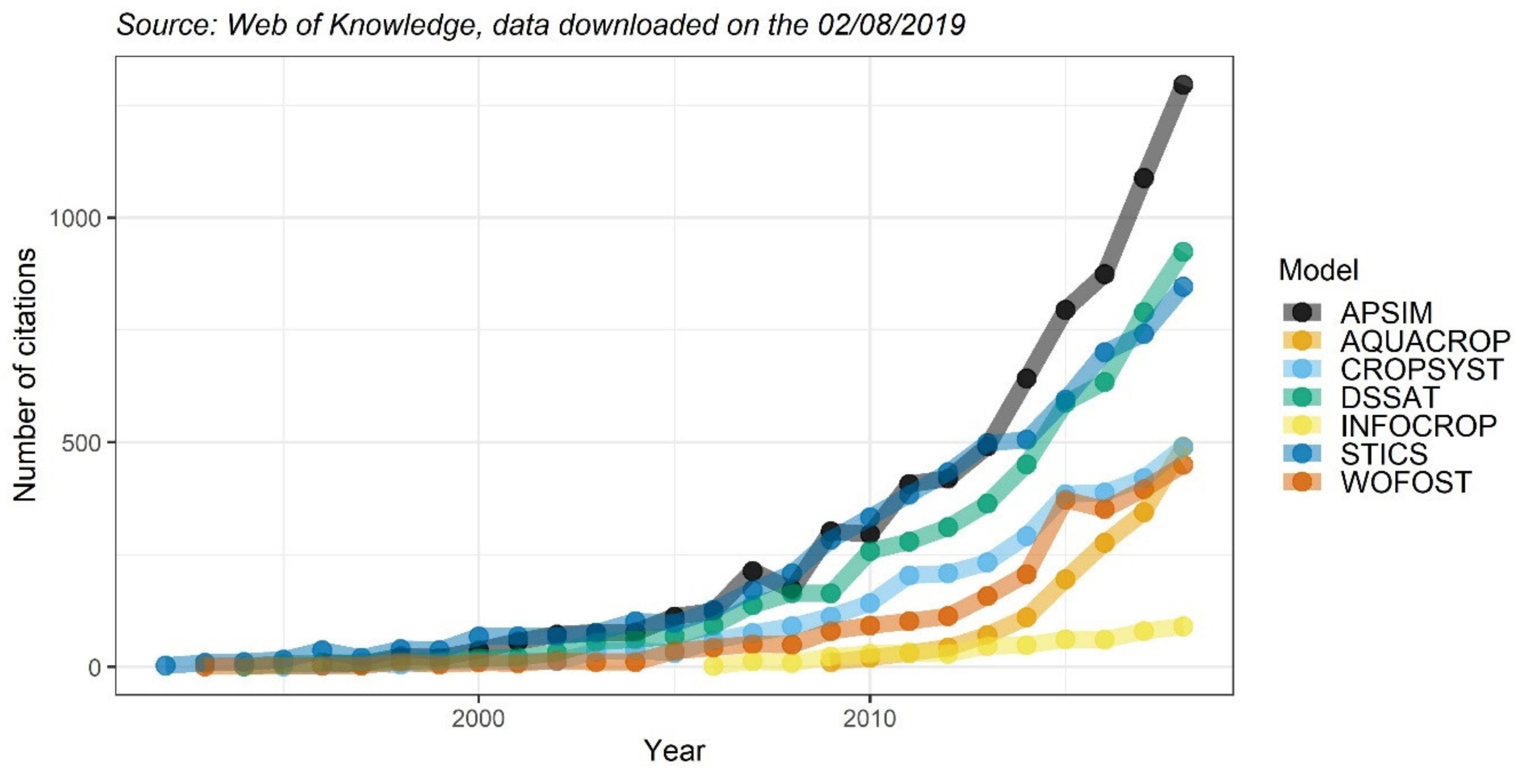
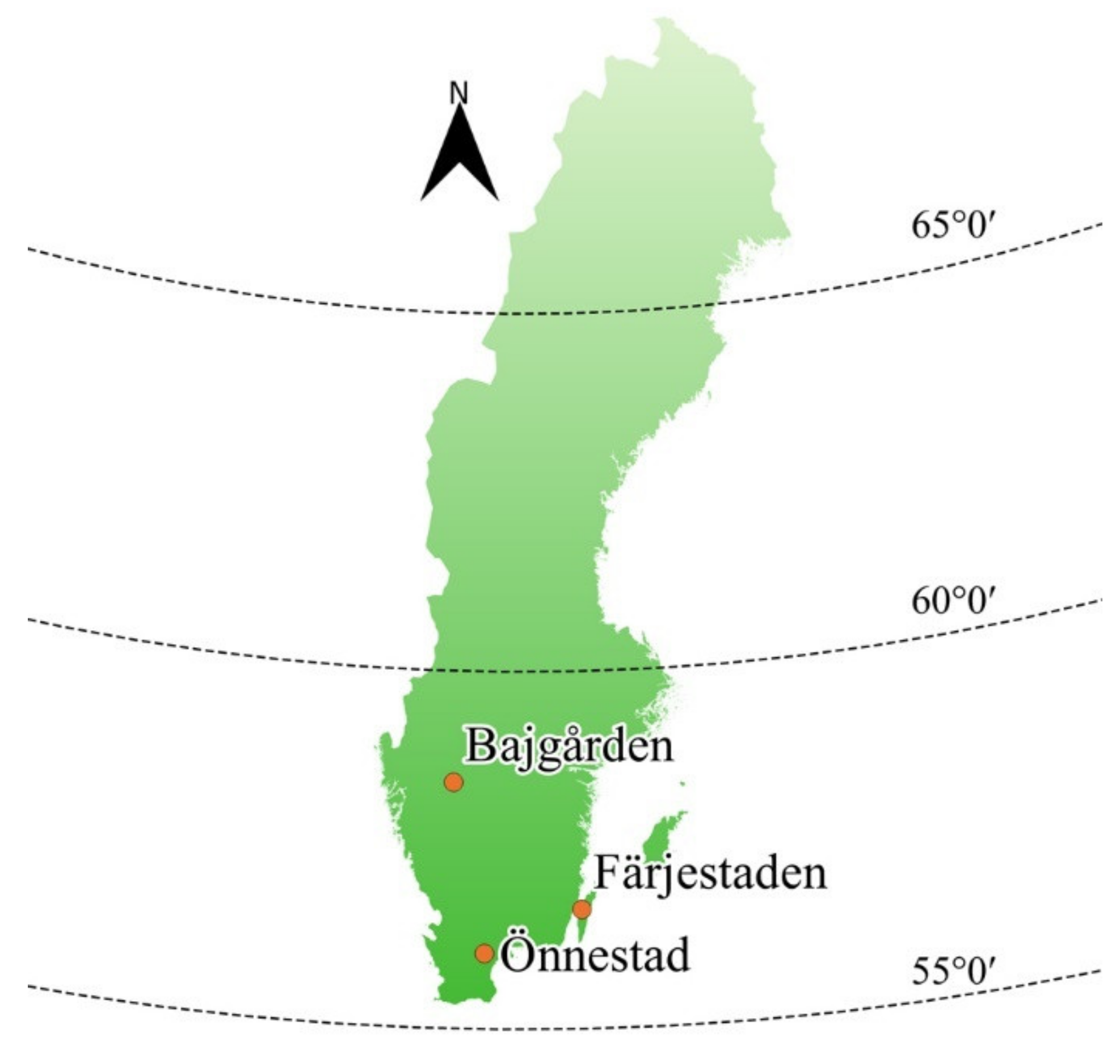
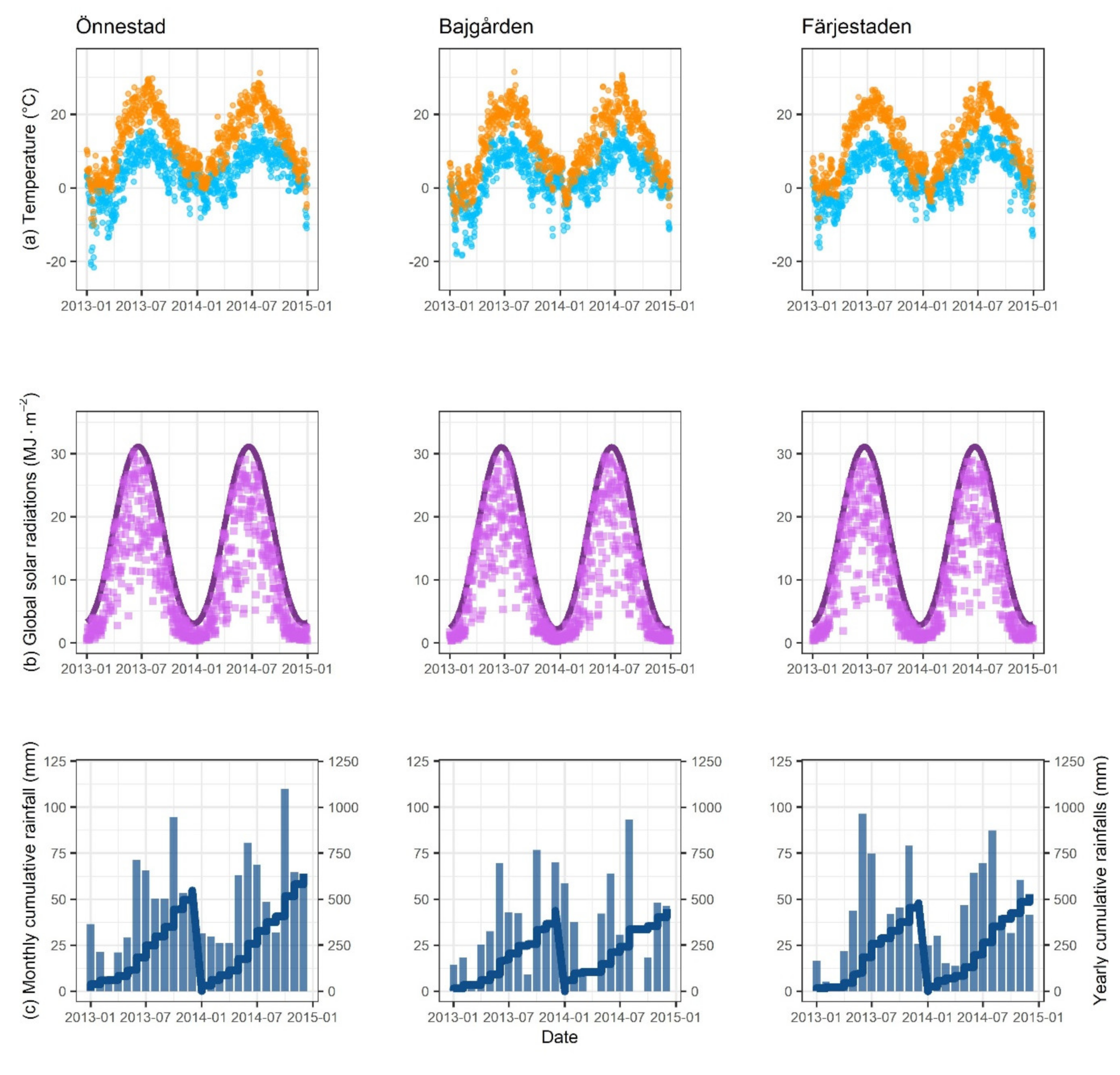
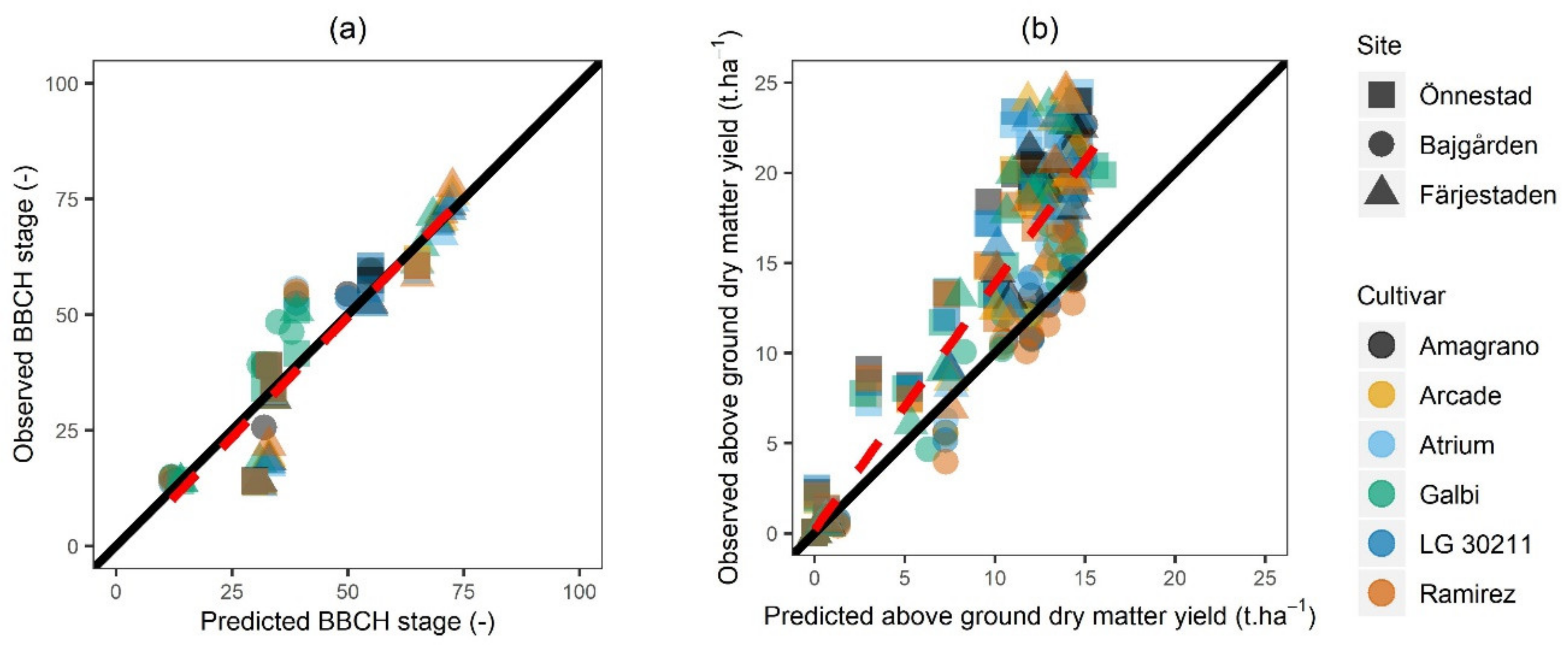
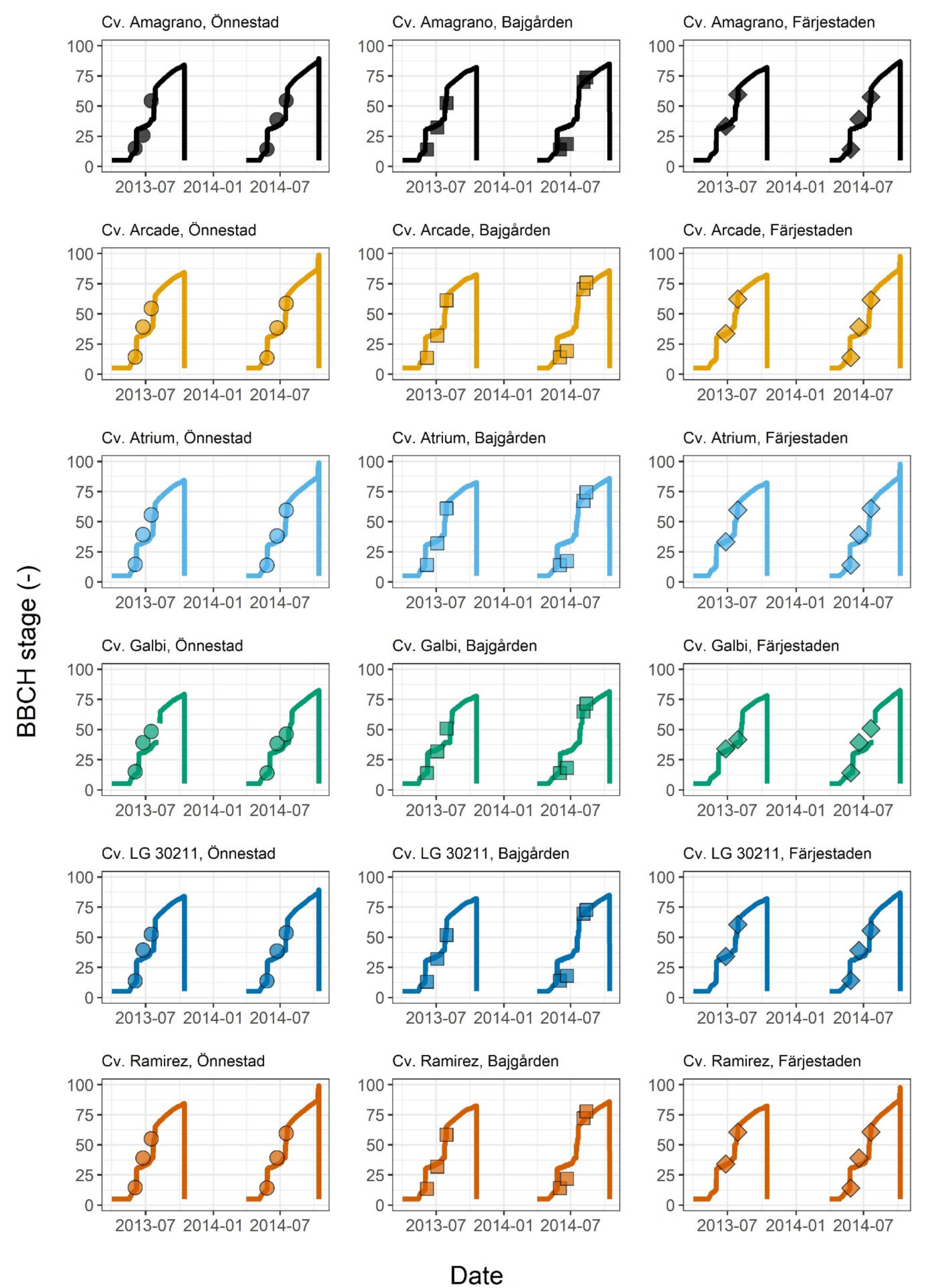

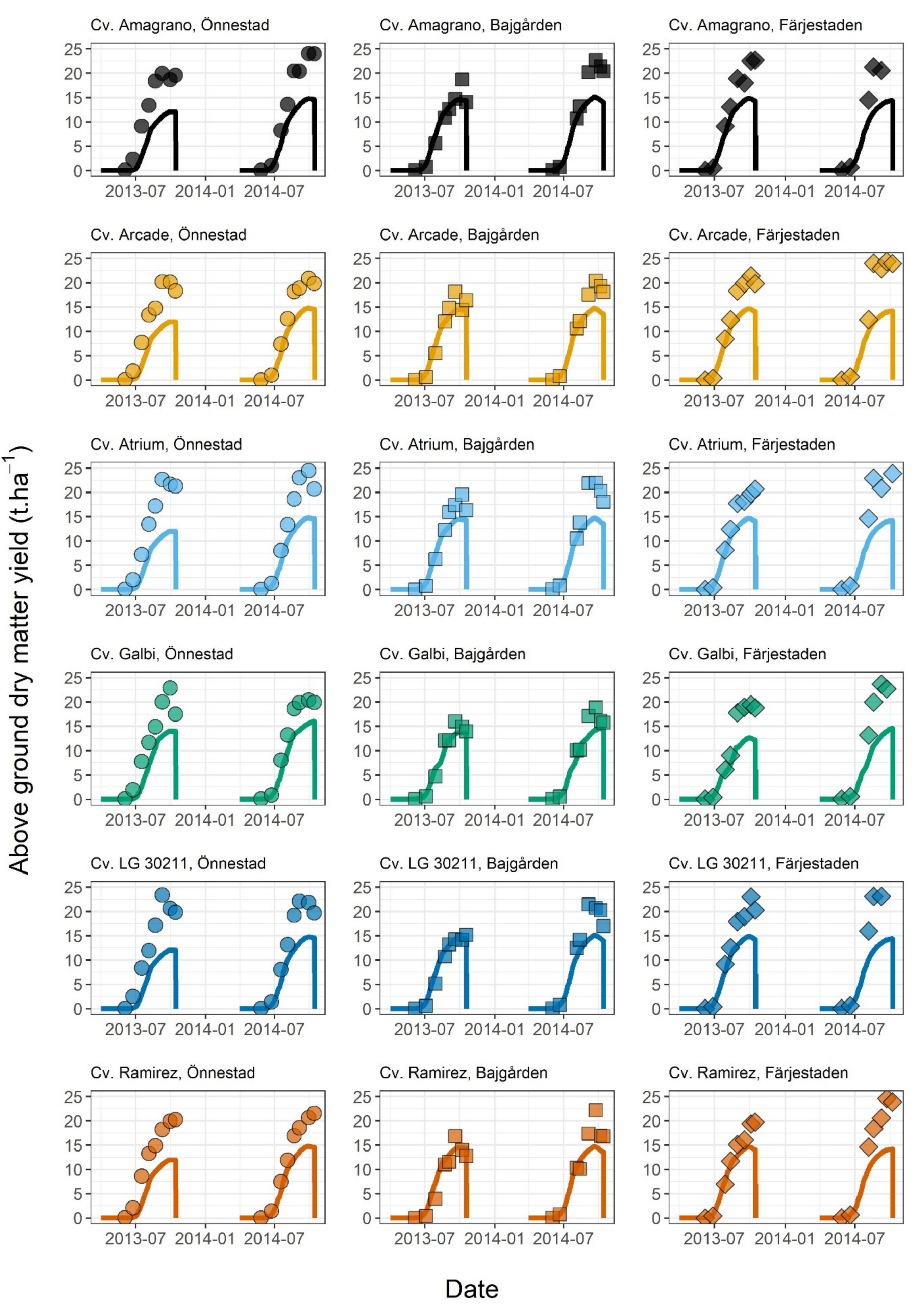
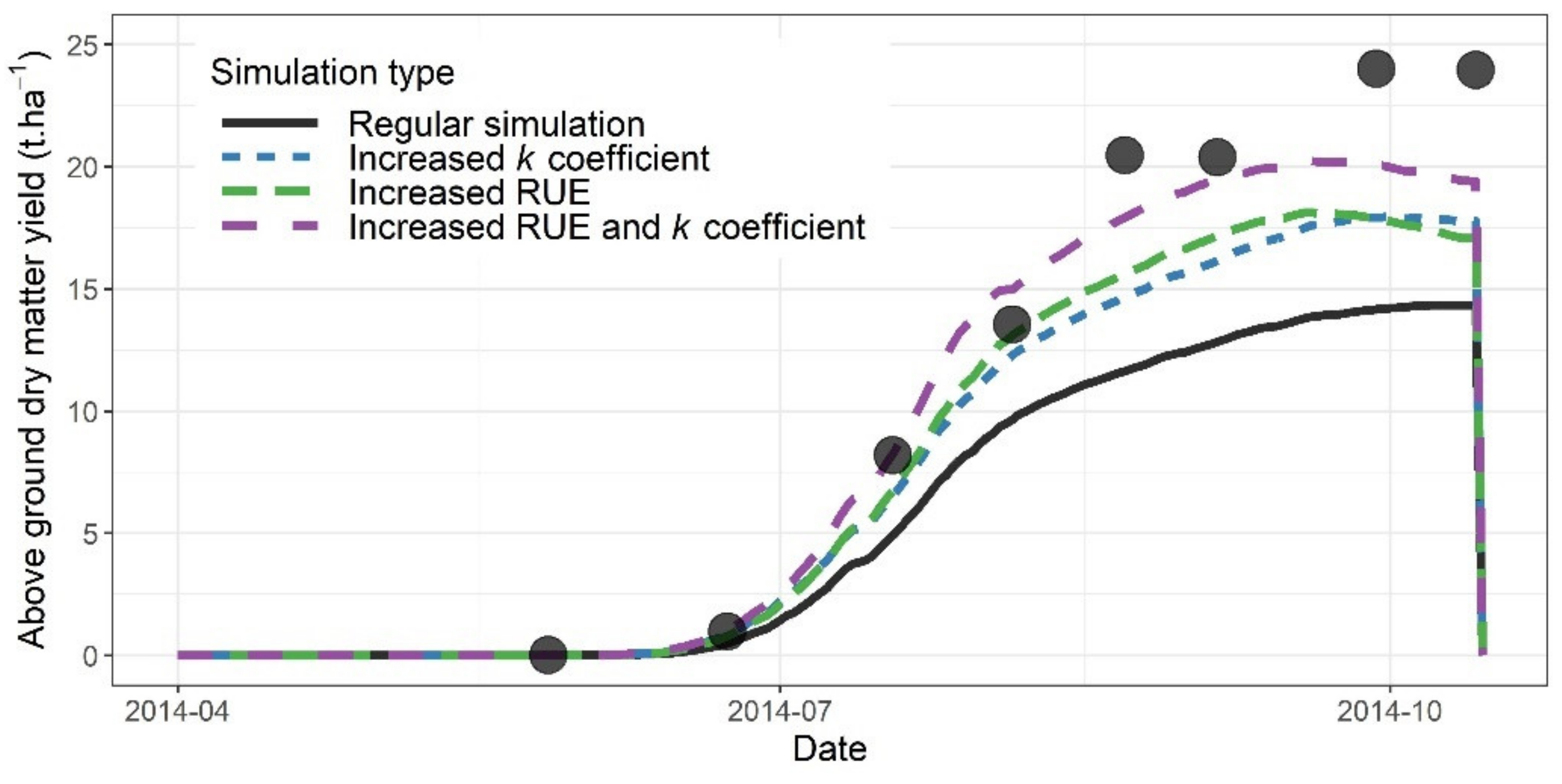
| Site | Year | Sowing Date | Sowing Depth | Sowing Density | Nitrogen Input at Sowing | Row Spacing |
|---|---|---|---|---|---|---|
| (-) | (-) | (-) | (mm) | (seed.m−2) | (kg.ha−1) | (mm) |
| Bajgården | 2013 | 13 May | 20 | 8.5 | 100 | 700 |
| 2014 | 30 April | 20 | 10 | 100 | 700 | |
| Färjestaden | 2013 | 11 May | 20 | 9 | 100 | 750 |
| 2014 | 28 April | 20 | 8.5 | 100 | 750 | |
| Önnestad | 2013 | 30 April | 20 | 9 | 110 | 750 |
| 2014 | 26 April | 20 | 9 | 110 | 750 |
| Parameter Name (Abbreviation) | Short Description |
|---|---|
| Emergence lag (ShootLag) | Thermal time target (°C) from germination to the emergence of the plant |
| Juvenile phase (JUV) | Thermal time target (°C) from emergence to the beginning of the photosensitive stage |
| Phyllochron (PC x) | Number of leaf tips that have appeared |
| Phyllochron (PC y) | Leaf rate appearance (°C−1) |
| Parameter Name (Abbreviation) | Range (Minimum–Maximum) |
|---|---|
| Emergence lag (ShootLag) | 15–45 |
| Juvenile phase (JUV) | 100–205 |
| Phyllochron (PC x) | 1|4|4.2|10.5|11–1|4|11|15 |
| Phyllochron (PC y) | 26|26|40|40|60–26|40|70|90 |
| Variable | n | a | b | R2 | RMSE | NRMSE | Index of Agreement |
|---|---|---|---|---|---|---|---|
| BBCH | 108 | 1.04 | −2.5 | 0.81 | 8.8 p.u. | 0.23 | 0.94 |
| ADMY | 282 | 1.32 | 0.12 | 0.87 | 5.2 t.ha−1 | 0.41 | 0.87 |
| Cultivar | ShootLag | JUV | PC x | PC y | RMSE | FAO Number |
|---|---|---|---|---|---|---|
| Amagrano | 45 | 100 | 1|4|4.2|10.5|11 | 26|26|40|40|65 | 9.0 | 200 |
| Arcade | 45 | 100 | 1|4|4.2|10.5|11 | 26|26|40|40|60 | 9.1 | 160 |
| Atrium | 45 | 100 | 1|4|4.2|10.5|11 | 26|26|40|40|60 | 9.4 | 210 |
| Galbi | 35 | 160 | 1|4|4.2|10.5|11 | 26|26|40|40|60 | 7.0 | 220 |
| LG 30211 | 45 | 100 | 1|4|4.2|10.5|11 | 26|26|40|40|65 | 9.0 | 210 |
| Ramirez | 45 | 100 | 1|4|4.2|10.5|11 | 26|26|40|40|60 | 9.2 | 170 |
© 2020 by the authors. Licensee MDPI, Basel, Switzerland. This article is an open access article distributed under the terms and conditions of the Creative Commons Attribution (CC BY) license (http://creativecommons.org/licenses/by/4.0/).
Share and Cite
Morel, J.; Parsons, D.; Halling, M.A.; Kumar, U.; Peake, A.; Bergkvist, G.; Brown, H.; Hetta, M. Challenges for Simulating Growth and Phenology of Silage Maize in a Nordic Climate with APSIM. Agronomy 2020, 10, 645. https://doi.org/10.3390/agronomy10050645
Morel J, Parsons D, Halling MA, Kumar U, Peake A, Bergkvist G, Brown H, Hetta M. Challenges for Simulating Growth and Phenology of Silage Maize in a Nordic Climate with APSIM. Agronomy. 2020; 10(5):645. https://doi.org/10.3390/agronomy10050645
Chicago/Turabian StyleMorel, Julien, David Parsons, Magnus A. Halling, Uttam Kumar, Allan Peake, Göran Bergkvist, Hamish Brown, and Mårten Hetta. 2020. "Challenges for Simulating Growth and Phenology of Silage Maize in a Nordic Climate with APSIM" Agronomy 10, no. 5: 645. https://doi.org/10.3390/agronomy10050645
APA StyleMorel, J., Parsons, D., Halling, M. A., Kumar, U., Peake, A., Bergkvist, G., Brown, H., & Hetta, M. (2020). Challenges for Simulating Growth and Phenology of Silage Maize in a Nordic Climate with APSIM. Agronomy, 10(5), 645. https://doi.org/10.3390/agronomy10050645






